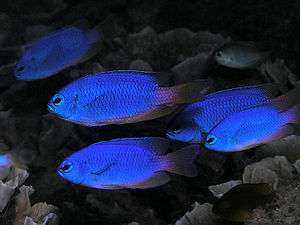Damselfish

Damselfishes[1] comprise the family Pomacentridae except those of the genera Amphiprion and Premnas, which are the anemonefishes. They can grow up to 14 inches (36 cm) long. While most are marine, a few species inhabit the lower stretches of rivers in fresh water. Damselfish usually have bright colors.

Habitat
Many species live in tropical coral reefs, and many of those are kept as marine aquarium pets. Their diets include small crustaceans, plankton, and algae. However, many also live in temperate climates, such as the large orange Garibaldi, which inhabits the coast of southern California and the Pacific Mexican coast.
Foraging
The domino damselfish D. albisella spends the majority (greater than 85%) of its daytime hours foraging. Larger individuals typically forage higher in a water column than do smaller ones. Damselfish of all sizes feed primarily on caridea and copepods. Males have relatively smaller stomach sizes during spawning season compared to females due to the allocation of resources for courtship and the guarding of nests. When current speeds are low, the damselfish forages higher in a water column where the flux of plankton is greater and they have a larger food source. As current speeds increase, it forages closer to the bottom of the column. Feeding rates tend to be higher when currents are faster. Smaller fishes forage closer to their substrates than do larger ones, possibly in response to predation pressures.[2]
Territoriality
The threespot damselfish S. planifrons is very territorial and defends its food and reproductive sites vigorously from intruders. Females leave their territories temporarily during spawning in order to deposit their eggs in male territories. This increased mobility subjects them to greater risks of predation, and females typically exhibit higher turnover rates than males do. Male damselfish defend their clutches until the larvae hatch. They do so by continuously swimming in a circular pattern around their nests. Males compete against each other for reproductive territorial space. Smaller and less aggressive individuals are often relegated to secondary or suboptimal habitats and therefore exhibit lesser reproductive success. Some are excluded from establishing territories altogether and usually exist as a floating population. These fish do not take part in breeding and are at the greatest risk of predation. However, they may occupy territories that have been vacated whenever the opportunity arises.[3]
The dusky damselfish S. adustus spends the majority of its life within a territory that is only approximately 0.6 square meters in area. These territories provide them with hiding spots, dietary needs, and spawning sites. Individuals in suboptimal territories frequently attempt to relocate, and so those in optimal habitats must constantly monitor territorial occupancy. Territorial aggression is often proportional to territory quality. Movements outside of territorial borders, called forays, are common and may span distances of sixteen meters or more. Three types of forays exist. The shortest-distance ones are involved in foraging. Longer forays usually involve courtship activity and mating. Non-feeding and non-reproductive forays are associated with territorial reoccupation.[4]The blue velvet damsel fish is very aggressive against other male blue velvet damsels.
Courtship
In the species S. partitus, females do not choose to mate with males based on size. Even though large male size can be advantageous in defending nests and eggs against conspecifics among many animals, nest intrusions are not observed in this damselfish species. Females also do not choose their mates based upon the brood sizes of the males. In spite of the increased male parental care, brood size does not affect egg survival, as eggs are typically taken during the night when the males are not defending their nests. Rather, female choice of mates is dependent on male courtship rate. Males signal their parental quality by the vigor of their courtship displays, and females mate preferentially with vigorously-courting males.[5][6]
Male damselfish perform a courtship behavior called the signal jump, in which they rise in a water column and then rapidly swim back downward. The signal jump involves large amounts of rapid swimming, and females choose mates based on the vigor with which males do so. Females determine the male courtship rates using sounds that are produced during signal jumps. As the male damselfish swims down the water column, it creates a pulsed sound. Male courtship varies in the number and rates of those pulses.[7]
In the beaugregory damselfish S. leucostictus males spend more time courting females that are larger in size. Female size is significantly correlated with ovary weight, and males intensify their courtship rituals for the more fecund females. Research has shown that males that mate with larger females do indeed receive and hatch greater numbers of eggs.[8]
Mating
Male bicolor damselfish, E. partitus, exhibit polygamy, often courting multiple females simultaneously. Among this species, evolutionary selection favors those males that begin mating as soon as possible during spawning seasons even if the most favorable egg clutches are spawned at later times. Females often choose which males to mate with depending on the males’ territory quality. Shelter sites are essential for the bicolor damselfish in avoiding predation, and females may evaluate the suitability of these sites at a male territory before depositing their eggs.[9]
Effect of distance on spawning
In the species S. nigricans, females usually mate with a single male each morning during spawning seasons. At dawn, they visit males’ territories to spawn. The distance to the territory of a mate influences the number of visits that a female undergoes with a male. At short distances, females make many repeated visits. At longer ones, they may spawn their entire clutch in one visit. This plasticity in mating behavior can be attributed to two factors: (1) intrusions by other fish to feed in the females’ territories while they are away, which could make the females return frequently to their habitats in order to defend their resources, and (2) predatory attacks on the females, which increase in frequency as the distances that the females travel become longer. Intrusion by other fish into a female’s territory can diminish the habitat of its food and render it unstable. Thus, a spawning female should return to its home as often as possible. However, a greater number of spawning visits increases the chance of being attacked, especially when mating with males that are far away. To minimize overall costs, females change their number of spawning visits depending on male territory distance.[10]
Filial cannibalism
The male cortez damselfish, S. rectifraenum, is known to engage in filial cannibalism. Studies have shown it typically consumes over twenty-five percent of its clutches. The males generally consume clutches that are smaller than average in size, as well as those that are still in the early stages of development. Female cortez damselfish tend to deposit their eggs with males who are already caring for early-stage eggs, rather than males with late-stage eggs. This preference is seen particularly in females that deposit smaller-sized clutches, which are more vulnerable to being consumed. For the males, filial cannibalism is an adaptive response to clutches that do not provide enough benefits to warrant the costs of parental care.[11]
Notes
- ↑ Froese, Rainer, and Daniel Pauly, eds. (2006). "Pomacentridae" in FishBase. April 2006 version.
- ↑ Mann, David A.; Gorka Sancho (10 September 2007). "Feeding Ecology of the Domino Damselfish, Dascyllus albisella". Copeia. 3 (3): 566–576. doi:10.1643/0045-8511(2007)2007[566:feotdd]2.0.co;2.
- ↑ Williams, Ann Houston (1978). "Ecology of threespot damselfish: Social organization, age structure, and population stability". Journal of Experimental Marine Biology and Ecology. 34 (3): 197–213. doi:10.1016/s0022-0981(78)80002-1.
- ↑ Bartels, Paul Jon (December 1984). "Extra-Territorial Movements of a Perennially Territorial Damselfish Eupomacentrus dorsopunicans Poey". Behaviour. 91 (4): 312–322. doi:10.1163/156853984x00137.
- ↑ Knapp, Roland A.; John T. Kovach (1991). "Courtship as an honest indicator of male parental quality in the bicolor damselfish, Stegastes partitus". Behavioral Ecology. 2 (4): 295–300. doi:10.1093/beheco/2.4.295.
- ↑ Knapp, Roland A.; Robert R. Warner (May 1991). "Male parental care and female choice in the bicolor damselfish, Stegastes partitus: bigger is not always better". Animal Behaviour. 41 (5): 747–756. doi:10.1016/s0003-3472(05)80341-0.
- ↑ Mann, David A.; Phillip S. Lobel (15 February 1997). "Propagation of damselfish (Pomacentridae) courtship sounds". The Journal of the Acoustical Society of America. 101 (6): 3783–3791. Bibcode:1997ASAJ..101.3783M. doi:10.1121/1.418425.
- ↑ Itzkowitz, M.; M. J. Draud; J. L. Barnes; M. Haley (March 1998). "Does It Matter That Beaugregory Damselfish Have a Mate Preference?". Behavioral Ecology and Sociobiology. 42 (3): 149–155. doi:10.1007/s002650050425.
- ↑ Schmale, Michael C. (November 1981). "Sexual selection and reproductive success in males of the bicolor damselfish, Eupomacentrus partitus (Pisces: Pomacentridae)". Animal Behaviour. 29 (4): 1172–1184. doi:10.1016/s0003-3472(81)80069-3.
- ↑ Karino, Kenji; Tetsuo Kuwamura (1997). "Plasticity in Spawning Visits of Female Damselfish, Stegastes nigricans: Effect of Distance to Mates". Behavioral Ecology and Sociobiology. 41 (1): 55–59. doi:10.1007/s002650050363.
- ↑ Petersen, Christopher W.; Karen Marchetti (January 1989). "Filial cannibalism in the Cortez Damselfish stegastes rectifraenum". Evolution. 43 (1): 158–168. doi:10.2307/2409171.
External links
- Tiny Damselfish May Destroy A Caribbean Reef National Public Radio, 11 August 2009.